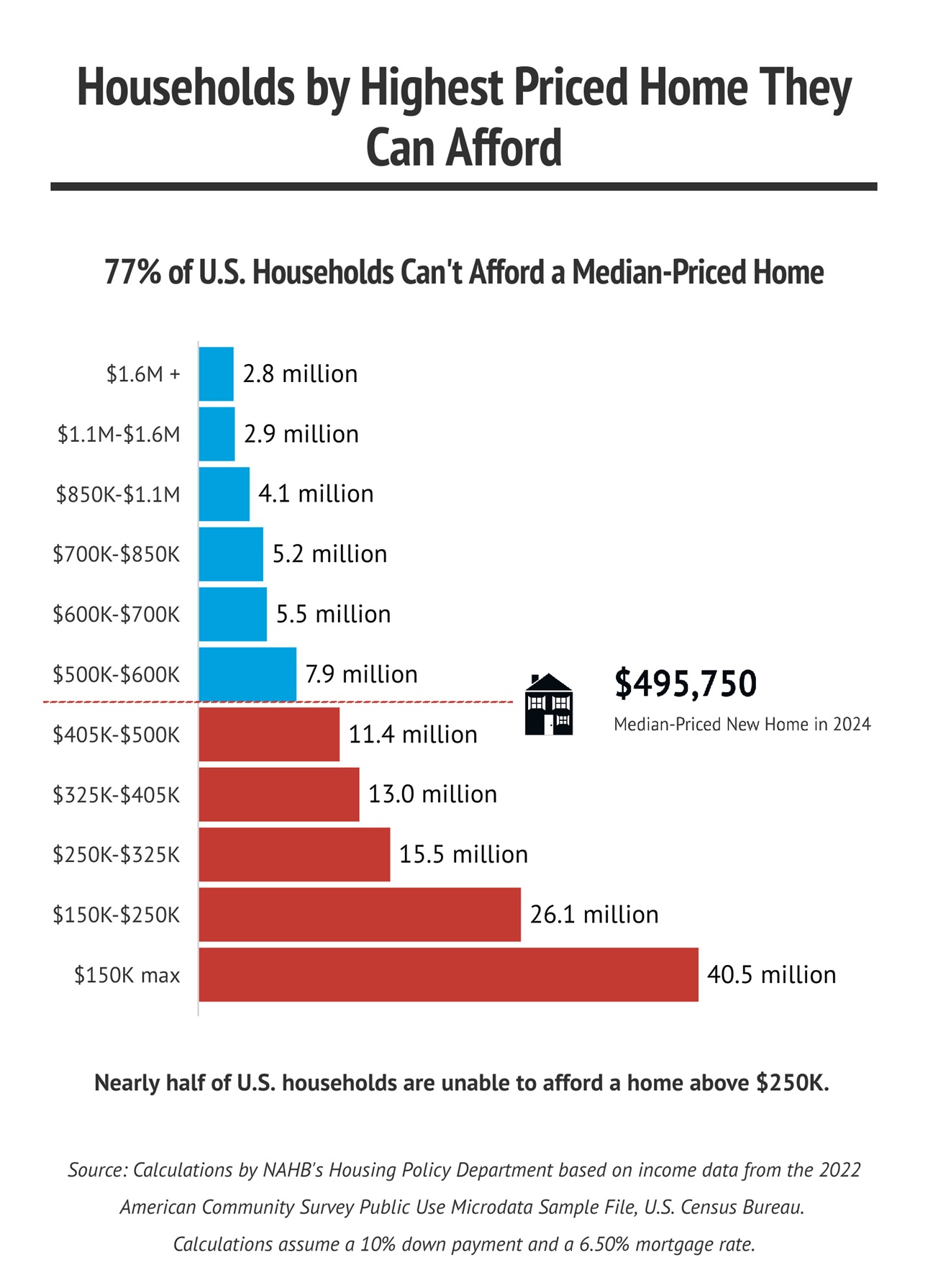Nearly Half of U.S. Households Can’t Afford a $250,000 Home
NAHB has updated its housing affordability graph for 2024, and the latest data show that 66.6 million households, 49% out of a total of 134.9 million, are unable to afford a $250,000 home.
The graph is based on conventional underwriting standards that assume the cost of a mortgage, property taxes and property insurance should not exceed 28% of household income. Based on this methodology, NAHB economists have calculated how many households have enough income to afford a home at various price thresholds.

For example, the minimum income required to purchase a $150,000 home with a mortgage rate of 6.5% is $45,975. At the base of the graph are 40.5 million U.S. households with insufficient incomes (below $45,975) to be able to afford a $150,000 home.
The graph’s second step consists of 26.1 million with enough income to afford a top price somewhere between $150,000 and $250,000. Adding up the bottom two rungs shows that there are 66.6 million households who cannot afford a $250,000 home.
The nationwide median price of a new single-family home is $495,750, meaning half of all new homes sold in the U.S. cost more than this figure and half cost less. A total of 134.9 million households — roughly 77% of all U.S. households — cannot afford this median-priced new home based on a mortgage rate of 6.5%.
The top of the graph shows that 9.8 million households (adding up the top three rungs) have enough income to buy a $850,000 home, and 2.8 million even have enough for a home priced at $1.6 million. But market analysts should never focus on this to the exclusion of the wider steps that support the graph’s base.
This graph clearly illustrates the nation’s housing affordability crisis. NAHB has put out a 10-point plan to address this urgent issue. The plan outlines initiatives that can be taken at the local, state and federal levels to address the root of the problem — impediments to increasing the nation’s housing supply.
Latest from NAHBNow
Dec 23, 2025
The 5 Types of Builders — and the One Built to ProsperMost builders want the same things: predictable profits, less stress, and a business that doesn’t grind them down year after year.
Dec 23, 2025
Lumber Capacity Has Peaked for 2025An annual revision to the Federal Reserve G.17 Industrial Production report shows current sawmill production levels above 2017 by 7.5%, but just 0.3% above 2023 levels.
Latest Economic News
Dec 22, 2025
State-Level Employment Situation: September 2025In September 2025, nonfarm payroll employment was largely unchanged across states on a monthly basis, with a limited number of states seeing statistically significant increases or decreases. This reflects generally stable job counts across states despite broader labor market fluctuations. The data were impacted by collection delays due to the federal government shutdown.
Dec 19, 2025
Existing Home Sales Edge Higher in NovemberExisting home sales rose for the third consecutive month in November as lower mortgage rates continued to boost home sales, according to the National Association of Realtors (NAR). However, the increase remained modest as mortgage rates still stayed above 6% while down from recent highs. The weakening job market also weighed on buyer activity.
Dec 18, 2025
Lumber Capacity Lower Midway Through 2025Sawmill production has remained essentially flat over the past two years, according to the Federal Reserve G.17 Industrial Production report. This most recent data release contained an annual revision, which resulted in higher estimates for both production and capacity in U.S. sawmills.
